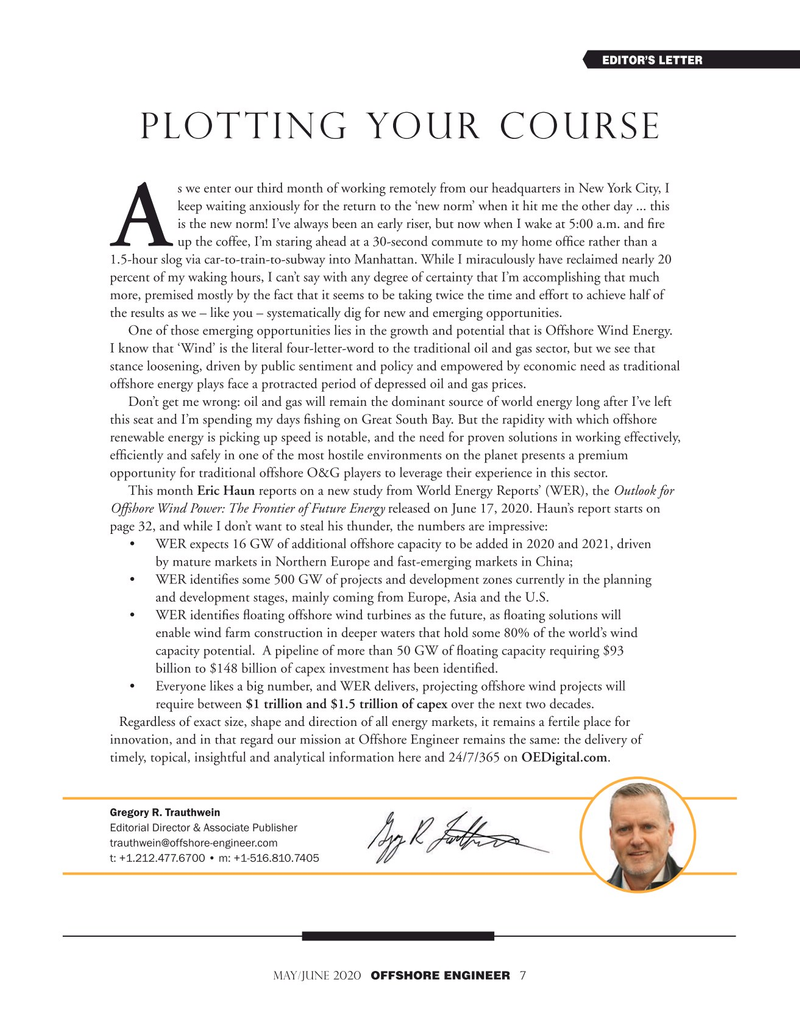
Page 7: of Offshore Engineer Magazine (May/Jun 2020)
Read this page in Pdf, Flash or Html5 edition of May/Jun 2020 Offshore Engineer Magazine
EDITOR’S LETTER
Plotting your Course s we enter our third month of working remotely from our headquarters in New York City, I keep waiting anxiously for the return to the ‘new norm’ when it hit me the other day ... this is the new norm! I’ve always been an early riser, but now when I wake at 5:00 a.m. and fre
A up the coffee, I’m staring ahead at a 30-second commute to my home offce rather than a 1.5-hour slog via car-to-train-to-subway into Manhattan. While I miraculously have reclaimed nearly 20 percent of my waking hours, I can’t say with any degree of certainty that I’m accomplishing that much more, premised mostly by the fact that it seems to be taking twice the time and effort to achieve half of the results as we – like you – systematically dig for new and emerging opportunities.
One of those emerging opportunities lies in the growth and potential that is Offshore Wind Energy.
I know that ‘Wind’ is the literal four-letter-word to the traditional oil and gas sector, but we see that stance loosening, driven by public sentiment and policy and empowered by economic need as traditional offshore energy plays face a protracted period of depressed oil and gas prices.
Don’t get me wrong: oil and gas will remain the dominant source of world energy long after I’ve left this seat and I’m spending my days fshing on Great South Bay. But the rapidity with which offshore renewable energy is picking up speed is notable, and the need for proven solutions in working effectively, effciently and safely in one of the most hostile environments on the planet presents a premium opportunity for traditional offshore O&G players to leverage their experience in this sector.
This month Eric Haun reports on a new study from World Energy Reports’ (WER), the Outlook for
Offshore Wind Power: The Frontier of Future Energy released on June 17, 2020. Haun’s report starts on page 32, and while I don’t want to steal his thunder, the numbers are impressive: • WER expects 16 GW of additional offshore capacity to be added in 2020 and 2021, driven b y mature markets in Northern Europe and fast-emerging markets in China; • WER identifes some 500 GW of projects and development zones currently in the planning and development stages, mainly coming from Europe, Asia and the U.S. • WER identifes foating offshore wind turbines as the future, as foating solutions will enable wind farm construction in deeper waters that hold some 80% of the world’s wind capacity potential. A pipeline of more than 50 GW of foating capacity requiring $93 billion to $148 billion of capex investment has been identifed. • Everyone likes a big number, and WER delivers, projecting offshore wind projects will r equire between $1 trillion and $1.5 trillion of capex over the next two decades.
Regardless of exact size, shape and direction of all energy markets, it remains a fertile place for innovation, and in that regard our mission at Offshore Engineer remains the same: the delivery of timely, topical, insightful and analytical information here and 24/7/365 on OEDigital.com.
Gregory R. Trauthwein
Editorial Director & Associate Publisher [email protected] t: +1.212.477.6700 • m: +1-516.810.7405
MAY/JUNE 2020 OFFSHORE ENGINEER 7

 6
6

 8
8